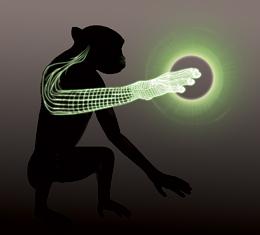
当谈到假肢,你不可能强过天行者卢克在美国电影《星球大战》中使用的那只“手”。这个机械手不但能够让他灵活地挥舞激光剑,甚至每根手指在受伤时都能感觉到疼痛。尽管现实生活中由大脑控制的假肢能够帮助截肢者捡起一根铅笔,然而如何让假肢真的产生触觉却依然是一项挑战。如今,通过向大脑的运动和感觉区域植入电极,研究人员创造了一个让猴子仅用意念控制的虚拟假肢,并让它们能够感受到虚拟的纹理。
美国北卡罗来纳州达勒姆市杜克大学的神经系统学家Miguel Nicolelis的研究团队之前曾开发出一种所谓的大脑—机器界面。然而Nicolelis说,这些系统中的一个陷阱便是“没有人能够关闭控制一个假肢与感到物理触觉之间的循环”。因此他和同事决定利用一种虚拟系统创建一个“大脑—机器—大脑”界面。
研究人员向一只猴子的大脑中植入了两组微型电极——一组位于运动控制中心,另一组则安放在处理左前肢物理触觉的躯体感觉皮质中。利用第一组电极,猴子能够在一张电脑屏幕上控制一条虚拟的假肢,并用手触摸由不同“材质”制成的虚拟盘子。其间,第二组电极则向大脑的感觉中心释放了一连串的电脉冲。一种低频脉冲表明是一种粗糙的纹理,而高频脉冲则代表了一种细腻的纹理,并且猴子很快便学会了辨识这种差别。
通过在确认正确的纹理后给予猴子奖励,研究人员发现,只需要4个训练步骤便可以使这些灵长类动物辨别不同碟子的纹理,即便在屏幕上打乱虚拟碟子的顺序也是如此。研究人员随后将电极移植到另一只猴子的大脑中负责处理下肢触觉的区域中,并最终得到了相同的结果。
研究人员在最新出版的《自然》杂志上报告了这一研究成果。
Nicolelis指出,尽管这些猴子都已成年,但其大脑的运动和触觉区域仍然具有令人惊讶的可塑性——看到自己控制一个假肢和感到物理触觉的结合,让它们“在几分钟之内”便认为这个虚拟的假肢属于自己。并且在整个实验过程中,猴子原有的触觉并未受到任何影响。Nicolelis表示:“大脑正在创造第六感。”
研究人员说,这项研究的最终目的就是能为瘫痪病人提供一套设备,让他们不仅能用大脑意念来控制这些假肢的行动,还能感受到“手”和“脚”上传回的感觉。
美国芝加哥大学的神经系统学家Sliman Bensmaia认为:“这一成果显然是大脑—计算机界面研究领域的一座里程碑。”他说,在正在研制的大量机械臂中,即便是那些最先进的也往往忽略了触觉的重要性。Bensmaia说:“感官反馈是做任何事情的关键。”即使像拿杯子这样的简单动作也需要大量的反馈,从而让佩戴者不会滑落或捏碎杯子。
但是Bensmaia认为这项研究刚刚起步。一条生物学手臂要接受无数的信息,不仅有材质上的,还有温度及其在空间所处的位置等。
相关英文论文摘要:
Active tactile exploration using a brain–machine–brain interface
Brain–machine interfaces use neuronal activity recorded from the brain to establish direct communication with external actuators, such as prosthetic arms. It is hoped that brain–machine interfaces can be used to restore the normal sensorimotor functions of the limbs, but so far they have lacked tactile sensation. Here we report the operation of a brain–machine–brain interface (BMBI) that both controls the exploratory reaching movements of an actuator and allows signalling of artificial tactile feedback through intracortical microstimulation (ICMS) of the primary somatosensory cortex. Monkeys performed an active exploration task in which an actuator (a computer cursor or a virtual-reality arm) was moved using a BMBI that derived motor commands from neuronal ensemble activity recorded in the primary motor cortex. ICMS feedback occurred whenever the actuator touched virtual objects. Temporal patterns of ICMS encoded the artificial tactile properties of each object. Neuronal recordings and ICMS epochs were temporally multiplexed to avoid interference. Two monkeys operated this BMBI to search for and distinguish one of three visually identical objects, using the virtual-reality arm to identify the unique artificial texture associated with each. These results suggest that clinical motor neuroprostheses might benefit from the addition of ICMS feedback to generate artificial somatic perceptions associated with mechanical, robotic or even virtual prostheses.
英文论文链接:https://www.nature.com/nature/journal/vaop/ncurrent/full/nature10489.html







